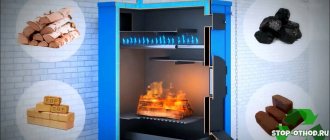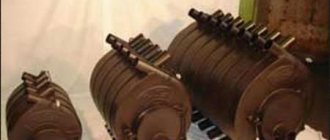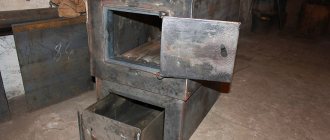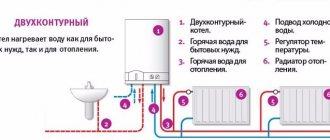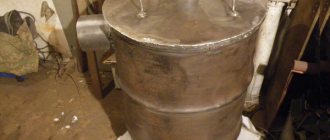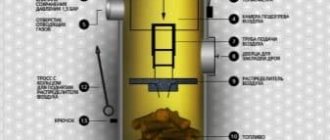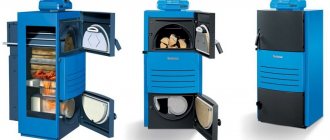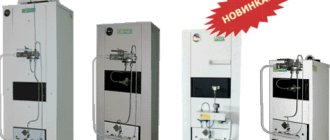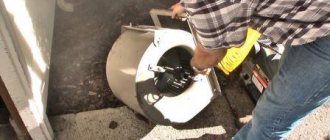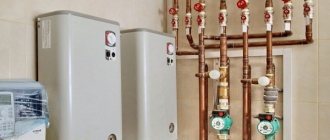Types of solid fuel boilers for heating a private home
Differences in solid fuel boilers are associated with:
- Resource supply technology.
- Existing combustion system.
Pellet
Automatic loading is done from the hopper. Depending on its volume, one bookmark is enough for a period of from a week to a month. Since the solid fuel boiler works independently, it is possible to adjust heating modes depending on the time of day and day of the week.
Photo 1. Solid fuel pellet boiler. On the right side of the device there is a hopper for loading pellets.
Automatic models of solid fuel boilers operate only on pellets. These are wood pellets that are obtained by pressing sawdust, shavings, bark, husks and other similar wood waste. Pellets do not burn, but smolder for a long time, releasing a significant amount of heat. Therefore, they provide a fairly high efficiency, up to 90-95%.
Important! Due to automation, a constant source of electricity will be required. In case of outages, it is advisable to purchase a UPS
With manual loading
Other types of solid fuel boilers are loaded only manually. The heat source is:
The service life of one fill depends on the volume of the fuel chamber and the combustion technologies used. For convenience, the boiler door is tilted. This makes loading and further maintenance of the device easier.
The disadvantage of such models of solid fuel boilers is the impossibility of automatic operation. Periodic human effort is required to maintain the process.
But dependence on electricity is reduced. In addition, different types of resources are used and it is easier to select the most available ones in a given area.
Reference. There are models of solid fuel boilers with automatic and mechanical temperature control. In the latter case, a mechanical draft regulator (damper) is used. It does not depend on the availability of electricity.
Solid fuel boilers with manual loading are divided into types depending on their design features. The following technologies are distinguished:
- classical;
- pyrolysis;
- long burning.
Classic
Such solid fuel boilers do not use technologies that increase the duration and efficiency of combustion. Therefore, the wood in them burns out quickly, within a few hours.
The efficiency of such boilers is low, since a significant part of the heat escapes through the chimney.
The advantages of such models of solid fuel boilers include low cost due to the fact that the internal design is simple.
Pyrolysis
As the name suggests, pyrolysis combustion technology is used. During primary combustion with a lack of oxygen, pyrolysis gases are formed, which are also capable of burning, releasing a significant amount of heat.
The design is more complicated compared to the classic version of solid fuel boilers. An additional combustion chamber is located above the main combustion chamber, where gases are collected and burned.
Thanks to this, the following increases:
- efficiency (up to 85-95% depending on the type of raw material);
- duration of one bookmark.
Other advantages of such solid fuel boilers include precise temperature control and less soot and slag. The disadvantages of boilers are:
- High price (pays off during operation).
- The need to use only dry fuel (otherwise the pyrolysis process will not begin).
Photo 2. The internal structure of a solid fuel pyrolysis boiler and the principles of its operation at different stages.
Long burning
Solid fuel boilers of this type use a different technology. Firewood does not burn from bottom to top, as in the classic version, but from top to bottom. Burning becomes slow and efficient. Therefore, adding firewood to the boiler lasts for up to a day or more, and coal for up to a week. Like pyrolysis boilers, these solid fuel boilers operate on all types of wood resources.
The main feature of heating boilers with an upper combustion method
Considering the difficulties with servicing solid fuel heating devices, manufacturers decided not only to use new technologies in the design of heating equipment, but also to return to traditional technologies. The main task that was solved in the process of modernizing boiler equipment was to increase the burning time of fuel per load. This result was achieved through the use of the top combustion principle in solid fuel boilers.
The technology of boiler operation due to top combustion is not something fundamentally new. Fuel loaded into the firebox burns from top to bottom. Those. on the contrary, not like in traditional type boilers. Combustion begins from the topmost layer, where the required air flow is supplied through a movable distributor. As the fuel mass burns, the air distributor moves down under its own weight, ensuring combustion of the next layer. The loaded fuel thus burns evenly layer by layer, releasing a large volume of combustible wood gas.
At this stage, the temperature in the furnace of the unit reaches 450 0 C.
At this stage, the principle of pyrolysis comes into play. The smallest combustion products, together with the emitted wood gas, completely burn, releasing a huge amount of thermal energy. As a result of the operation of the unit, there is practically no fuel residue left in the combustion chamber.
For reference: Pyrolysis is an exothermic reaction, as a result of which, under the influence of high temperature, the process of decomposition of organic compounds occurs, followed by the release of a flammable gaseous substance. The main heating of a solid fuel boiler during the combustion process is carried out by burning wood gas.
Wood (pyrolysis) gas enters the second chamber through a metal disk, where it ignites due to the forced hot air. The combustion temperature in the second furnace reaches enormous values at this moment, 500-800 0 C. Everything is simple and clear. The main thing is the design of the heating apparatus.
The combustion rate of the fuel depends on the combustion process. In classic-type heating equipment, wood is burned quickly enough, producing the maximum possible heat within a short period of time. In other words, for a short period the unit reaches the peak of its power, after which, without subsequent addition of fuel, the boiler begins to lose load. Constantly loading a new portion of firewood is not always convenient or physically possible. Solid fuel boilers with top loading work completely differently. One load with such a device can be enough for 12, 24 or more hours of operation. The intensity of combustion depends on the load on the heating system.
Everything is simple and clear. The main thing is the design of the heating apparatus.
Selection of heat generator based on combustion duration
You can visually distinguish a real long-burning TT boiler from others by the following characteristics:
- The product data sheet indicates the operating time from 1 load is at least 8 hours.
- The increased volume of the firebox increases the overall height of the unit, which is why such boilers are taller than their “brothers” with the same thermal power. Another option is to increase the depth of the firebox, causing the body to “grow” in length.
- For tall models, the distance between the loading and ash door is about 500 mm, no less. Some manufacturers provide their products with a third intermediate door for ease of use.
Modern long-burning boiler Atmos D30
Note. Pyrolysis and pellet heaters do not belong to this category, as they operate on a different principle.
Example. A solid fuel hot water boiler operating according to the usual scheme has a firebox volume of 50-65 liters with a power of 22 kW and a rated combustion duration of 6 hours using wood. The total volume of the firebox of a long-burning heat generator is 100 liters or more, and the useful volume (up to the level of the loading door) is 80 liters with a power of 20 kW (for example, ATMOS D30 and VIESSMANN VITOLIGNO 250-S). If we consider boilers with top combustion of wood such as the Baltic Stropuva, then the chamber volume reaches 260 liters (power 20 kW).
Heaters with top combustion of fuel can operate for 12-15 hours on wood and up to 3 days on anthracite, but have a number of disadvantages:
- logs cannot be added “on the go”, but only after the previous portion of firewood has completely burned;
- it is difficult to do short-term heating of the house;
- Fine fuel like sawdust or debris sometimes hangs on the walls.
More details about these heat generators are described in the video:
How a homemade long-burning boiler works
Principle of operation
The operation scheme of such boilers is based on the ability of solid fuel to smolder for several hours, while producing a large amount of thermal energy. It is typical that in this case the fuel is burned more completely, and the amount of waste, as a result, is noticeably reduced.
Boiler drawing
The main element of the boiler is the firebox, where combustion is limited and the intensity of the air supply is controlled using special devices. The fuel is loaded twice a day in large portions, after which it slowly smolders (the limited amount of oxygen does not allow it to burn fully).
The pipe through which the smoke is removed is passed through heat exchangers and heats the liquid in the heating system. It turns out that all you need to do is load fuel every 12 hours for uninterrupted heating of the house.
Boiler diagram
Main advantages
Long-burning boilers stand out from other types of heating systems. Of course, the main advantage is the duration of the work, but there are other important points:
- low fuel cost;
- autonomy;
- the ability to heat large areas at minimal costs;
- ease of installation and operation;
- safety;
- Possibility of making it at home.
Device structure
To make a boiler, it is more convenient to use a metal pipe ø30 cm or larger with a wall thickness of at least 5 mm (otherwise the latter will soon burn out due to the high temperature inside the device). The height of the structure can vary between 80 cm and 100 cm, it all depends on the area of the room.
Housing pipe
Regardless of the modification, the boiler consists of three main zones:
- loading area;
- zones of smoldering and heat generation;
- final combustion zones where ash burns and smoke gases are removed.
This element is made in the form of a metal circle 5-6 mm thick with a hole in the middle, through which oxygen is supplied to the firebox using a telescopic pipe. The diameter of the product should be slightly smaller than the diameter of the body. The height is adjusted using a special impeller.
Long-burning wood-burning boilerLong-burning wood-burning boiler
Long burning boiler
Air can be supplied in one of two ways:
- straight from the atmosphere;
- from a special heating chamber (it is located in the upper part of the structure), which ensures more efficient operation of the boiler.
A special air damper is used for adjustment.
The chimney pipe is welded on top. It must be perpendicular to the body for at least 0.5 m, otherwise excessive draft will be formed.
A door is equipped at the bottom to remove combustion products. Cleaning should be done infrequently, because the fuel will burn more completely.
There are two ways to heat the coolant, each has its own strengths and weaknesses.
Long burning boilerLong burning boiler
Method No. 1. A coil is connected to the heat exchanger pipe passing through the combustion zone, through which the water in the tank is heated.
Method No. 2. A separate metal tank is formed, through which the chimney pipe is passed. The hot smoke heats the liquid.
The first method is more effective, but at the same time more difficult to implement. The second one is easier to do, but it is only practical in small houses.
The best manufacturers of wood boilers
Since the efficiency of the heating system is primarily affected by the efficiency of a long-burning boiler, the quality and energy efficiency of the device are of fundamental importance. Currently, the leading positions in the solid fuel equipment market are occupied by the following companies:
Stropuva
The hallmark of this equipment is the truly long burning of one stack of firewood; when fully loaded, the boiler can operate for up to 30 hours. The boiler design, developed by Baltic engineers, became the prototype for most home-made heating boilers, which indicates the simplicity and reliability of the unit.
Сandle
Another Lithuanian brand specializing in the production of long-burning boilers for home heating. The main difference from the previous manufacturer is that all Candle modifications are designed exclusively for the use of firewood. The unit's passport states that the burning time of one full load of firewood is from 7 to 30 hours, however, in practice, it is extremely rare to achieve such indicators. The price of a wood-burning boiler, in our opinion, is somewhat overpriced.
Buderus
A well-known German brand produces long-burning pyrolysis heating boilers, the design of which is fundamentally different from the models discussed above. The combustion chamber for secondary gases is located below the combustion chamber, and air circulation in the system is ensured by a special fan. The high price of the installations is justified by the presence of automated control systems and the use of high-quality heat-resistant materials.
Wichlach
The products of the Ukrainian-Polish enterprise are distinguished by an optimal price-quality ratio. The design of the device allows you to extend the burning time of one bookmark to 48 hours. The wood-burning boiler reaches operating mode in 20–25 minutes, and a special air supply system ensures complete combustion of fuel along the entire perimeter of the combustion chamber.
Prometheus
The domestic development is strongly reminiscent of the German analogue, but differs favorably from it in the segmental design of the grate, which makes it possible to replace only damaged sections, and not the entire pipe. Wood-burning boilers are equipped with an Italian-made automatic control system, which provides precise control of the coolant temperature and the rotation speed of the blower fan.
Advantages of long-burning solid fuel boilers
We will not talk about all the advantages of heating boilers of this type in the article. Let's denote the main ones:
- High heat transfer rates.
- Highest performance with minimal fuel costs.
- Currently, manufacturers offer several models that differ in the number of circuits and the ability to automate the processes of temperature control and regulation.
- Lowest cost of fuel used. By the way, it should be noted that boilers of this type operate not only on wood or coal. Here you can use sawdust, seed husks, leaves, grass, plant stems and other flammable natural materials. It all just needs to be brought to a certain density. That is, subject the fuel to the pressing process.
- If we talk about the appearance of the boilers, the manufacturers made sure that their design complies with all the standards and requirements of our time.
Full compliance with installation requirements
How to choose the right boiler connection diagram
In order to keep the house warm, it is not enough to know what heating schemes are available with a solid fuel boiler. Craftsmen who have been creating heating systems for many years give the following recommendations:
- When creating a drawing of a heating circuit for a solid fuel boiler, you should first familiarize yourself with the types and operating principles of such heat generators. This can be a constant or long-burning heater, a pyrolysis or pellet unit, or a buffer. Each of these devices has its own operating criteria, which may be disadvantages for some, and advantages for others.
- To get an ideal heat supply scheme, you need to be able to combine the functioning of the boiler with the tank, since this element accumulates thermal energy. This is justified by the fact that the element heating the water can change its temperature in the range from 60 to 90 degrees. There is no constant indicator. Since solid fuel boilers are inert devices, this distinguishes them favorably from gas, diesel and electric analogues.
- When choosing a heating scheme, you need to objectively assess the risk of power outages. If there are frequent power outages in the area, then a system with a water pump will not only not pay for itself, but may quickly fail. Therefore, it is better to choose a type of heating with natural circulation.
- When choosing a piping, it is worth considering in advance the safety lines between the boiler and the tank. They are located at the points of the inlet and outlet pipes so that they are as close as possible to the water heater. Also, to achieve maximum effect, you need to try to keep the distance between the boiler and expansion tank to a minimum. But it is no longer possible to install safety valves or taps here.
- If a scheme with a pump was chosen, then it is installed on the return pipe, as close as possible to the heat generator. Thus, even if the lights are turned off and the pump stops working, the water will continue to move along the circuit, that is, minimal heat will be retained. The device must be installed along a bypass route. Only then will it be possible to disconnect it from the network (if necessary), and shut off the circuit itself using taps.
- There is such a thing as bypass. These are jumpers with taps that are placed between the supply line and the return pipe. This arrangement facilitates the return of “extra” hot water when the volume changes through the thermostat.
- A stainless steel valve must be installed in the chimney pipe. Since there is moisture in the smoke, albeit in small quantities, it is this that can provoke the destruction of the internal part.
Tying is a process that deserves special attention. Therefore, they design and install it only if they have complete confidence in their abilities. Nikolay Avramenko, 51 years old
Energodar
Nikolay Avramenko, 51 years old, Energodar
Having read the article, I would like to add my note. The topic of operational characteristics of solid fuel boilers was touched upon here. It was indicated that they have such a feature as high inertia. I would like to say that this phenomenon is not typical for pellet boilers. This is due to the fact that such devices have a burner that receives wood pellets in portions. Therefore, when the supply of raw materials stops, the flame immediately goes out. Although such boilers are not so cheap.
089aaee8336b4ccb28c7183ac916ddfa.jpe
Anton Abramov, 29 years old, Omsk
At one time, I was interested in the work of solid fuel boilers, as they offered me a position related to this area. I would like to leave a few words about the thermostat and its regulatory features. You need to understand that when a certain temperature is set, for example, at 85 degrees, even though the damper is closed, the burning and smoldering continues. Because of this, the water still heats up a couple of degrees, and only then it will be established accurately. Therefore, you should not turn the thermostat back and forth, otherwise this may lead to breakdown of the entire system.
Nikita Karpenko, 37 years old, Arkhangelsk
When we built a house outside the city, we planned to live there all year round. The time came when it came to heating, and I settled on a closed-type system with natural circulation. Firstly, it was quite easy for me to create it with my own hands, and secondly, we were already a little limited in money. I didn’t have any particular problems with the installation, but when the first cold weather arrived, I realized that there was clearly not enough heat for the house. So at school, I was quite good at physics, and I realized that heat is “lost” in areas where the pipes were left open. Taking a roll of mineral wool, I wrapped all the pipes that run in open areas. Literally by the end of the first day, our family felt a significant warming in the rooms. Therefore, you need to remember such moments.
How to make a long-term storage cauldron with your own hands
In fact, there is nothing complicated. You can create a long-burning wood-burning boiler yourself by studying the experience of one of the Internet craftsmen. For example, an interesting model of a classic boiler was proposed by Vitaly Dashko.
Boiler drawing by Vitaly Dashko
A detailed story about how you can make a long-burning boiler with your own hands, as well as the necessary drawings in this video.
Assembling a wood-burning heating boiler - step-by-step instructions.
Let's look at step-by-step instructions for creating a long-burning boiler with your own hands
| Photo | Actions |
| Let's figure out how to make a boiler with a power of 15 kW with your own hands. First of all, you need to create a drawing or at least draw a sketch in which you indicate the dimensions and the required number of metal plates and pipes. | |
| Our wood heating boiler measures 74x74 cm, width 40 cm. Power 15 kW. Material – 4 mm steel inside, 3 mm steel outside. | |
| The boiler loading tank uses the principle of oblique loading, which is very convenient when stacking logs. | |
| A lever for controlling the damper is mounted on the side wall. This helps to bleed air properly. | |
| On top of our boiler is equipped with a stove, the lid of which is removed, and we see the structure of the fuel receiver, note that it originates from the top of the ash chamber. | |
| Supports for the grate bars are welded inside the firebox. | |
| The heat exchanger uses 4 mm steel. Two-inch tubes are welded. Long-burning wood heating boilers do not heat up as much, so 4 mm steel is considered the best option. | |
| The cover for the stove is removable, this is done so that, if necessary, repair work can be carried out on the heat exchanger. | |
| The loading doors are hinged, the material is the same steel, but 3 mm thick. | |
| The lower cleaning door is made of the same material. There is a tight locking lever here. | |
| An air vent is provided on top of the chamber; it allows you to relieve pressure while firing the stove. | |
| An important rule is that a wood-burning heating boiler must be installed on a heat-resistant solution. | |
| The design of the chimney allows a plug to be added to the boiler. |
You should not use high-carbon steel above St20 for the firebox. Firstly, it is more expensive in price, and secondly, it overheats from welding and can crack at the joints. It is better to buy ready-made handles for doors with ebonite linings; they hold tighter and look more beautiful.
Do-it-yourself long-burning wood-burning boilers are sometimes a good solution to heating problems in the house.
Types of heating boilers
The type of boiler we are interested in is produced only in a floor-standing version - its mass is too large. And if you do not take into account the positions already described, then these are ordinary solid fuel boilers. Logic dictates that the power of such models depends on the intended purpose of the fuel unit. There are devices with minimum parameters - 7 kilowatts, and there are also with maximum parameters - up to 95 kilowatts. Such colas are mainly used for heating small houses. But there are also more powerful installations, for example, with 200 kilowatt power. They are used to heat houses with an area of more than 2000 square meters.
In the production of boilers, steel or cast iron is used, but even the steel differs from one manufacturer to another, which will affect the cost of the device. For example, heat-resistant metal is many times more expensive than low-grade metal, and, accordingly, such a boiler will cost more. Some models use fireclay bricks to line the firebox. This increases not only the cost of the unit, but also its strength and durability. By the way, such models can be single-circuit or double-circuit.
Heating boilers installation
This is not gas equipment, so you can install it yourself. True, there are several important warnings from experts:
- The boiler must be installed at a distance of at least half a meter from the nearest walls. The fact is that this heating device, even if it has a water jacket in its design, gets very hot. And if the walls of the house are built from flammable materials, they must be additionally sheathed with protection. For example, an asbestos sheet, brick or galvanized steel sheet, under which asbestos will still have to be laid.
- Any, even the most low-power boiler in this category, has a significant mass. Therefore, you need to take care of the frame on which it will be placed. The frame must be strong, non-flammable and reliable. Keep in mind that the weight of the boiler will increase due to the weight of the filling. Therefore, the best option is a free-standing foundation, built according to all construction canons with the laying of a crushed stone cushion and a reinforcing frame made of metal reinforcement. By the way, experts advise pouring a foundation at least half a meter high.
Safe Operation
The floor under the door must be covered with a steel sheet.
For the safe operation of long-burning solid fuel boilers with a water circuit, the following conditions will need to be met:
- the flooring under the combustion chamber door must be covered with a steel sheet measuring 700x500 mm;
- a layer of plaster 25 mm thick, reinforced with a metal mesh, is applied to the surface of the wall adjacent to the boiler body;
- the distance from the firebox door to the wall closest to it is made at least 125 cm;
- if it is impossible to fulfill the last two requirements, a steel sheet or asbestos blank 8 mm thick is mounted in this area - their upper cut is located 25 cm above the boiler level.
The gap between the floor and the bottom of the ash pit is selected taking into account the characteristics of the ceiling. If it is made of flammable material, this distance should be about 14 cm; otherwise the bottom is left at floor level. Issues related to safe handling of heating equipment also include the rules for igniting the boiler and loading it, which are described in detail in the user manual.
Pyrolysis boilers
The operating principle of these heat generators is based on separate combustion in two chambers communicating with each other through a nozzle made of refractory bricks. In the primary chamber, located on top, firewood smolders with limited air supply from the fan. As a result, a process of pyrolysis occurs, otherwise known as gasification, during which a mixture of flammable gases is released. It moves to the second chamber, where it is burned when secondary air enters. The working diagram of a pyrolysis boiler operating on solid fuel is as follows:
Flue gases from the secondary furnace enter the fire tube heat exchanger in the form of vertical flues surrounded by a water jacket. There they cool, transferring heat to the water, and leave the boiler through the chimney pipe. The performance of the fan is controlled by an electronic unit - controller, based on the readings of pressure and temperature sensors.
In general, the heat generator has good efficiency indicators - about 80%, but the unit is significantly more expensive than a classic one. In addition, the boiler shows high efficiency only when operating on dry wood, although this statement is also true for other solid fuel units.
The most popular units for private properties
Different models of wood boilers differ from each other:
- dimensions of combustion chambers;
- type of construction;
- material of manufacture.
The heat exchanger is often made of steel or cast iron. At the same time, cast iron will last longer than steel, it takes a long time to cool down, but can collapse under sudden temperature changes. Steel is heat-resistant, but can be subject to corrosion and will last on average about 10–15 years.
For country heating, simple single-circuit models are most often installed; for houses with year-round living, it is rational to install a double-circuit boiler. In the latter case, one circuit will provide heating, while the second will provide hot water supply.
Diagram: device of a pyrolysis boiler
Each individual unit has its own special technical characteristics, averaged data:
- power about 100 kW;
- coolant temperature at the outlet is 80 degrees, at the return - at least 50 degrees;
- working pressure on average 1 atm;
- boiler weight up to 400 kg;
- Duration of operation on one load of fuel is 10-12 hours.
Operation of the pyrolysis boiler Attention! When buying a heating boiler that runs on wood, you need to take into account that most units were originally designed to burn brown or hard coal. Their technical data sheets indicate the power and burning time of one bookmark based on operation on coal. Therefore, it is necessary to separately calculate the power and combustion time of the fuel if the heat generator runs on wood.
Recommendations for use
When installing a boiler, attention should first of all be paid to the quality of the chimney. Stainless steel pipes with a diameter of 120 to 200 mm (depending on the model) are best suited for it.
The ideal option would be a finished pipe with thermal insulation - a sandwich. Pipes with thick walls are not recommended. They take longer to warm up, and soot remains on the walls. It is necessary to clean the chimney once every 2 months.
When the boiler is turned on for the first time, an unpleasant odor may appear. Don't worry - this is normal, as special oil is applied to the metal during production. The first combustion should begin in a ventilated room, and the boiler should be turned on at maximum power. The duration of its operation in this mode is 1 hour.
The fuel is placed in the chamber in a loose layer so that there is an air gap between the firewood. This will allow them to ignite better. To control the combustion process in the ash chamber, the damper opens and closes.
Cleaning the boiler is allowed only after it has completely cooled down. During cleaning, it is recommended to leave some of the ash on the grate, which will serve as natural thermal insulation. This will extend the life of the element. To clean the boiler itself, use a wire brush or scraper. The smoke damper must be open at this time.
80f3086a9836111a624430b1379de635.jpe
Depending on what fuel is used, a certain amount of soot is formed during boiler operation. Coniferous wood produces more waste. Sometimes condensation may form in the chimney: this depends on the level of thermal insulation and the moisture content of the fuel. To reduce the soot layer, it is recommended to use aspen firewood.
Preparation for use
A solid fuel boiler (SFC) is a type of heating equipment that runs on wood, coal or pellets, providing room heating. Regardless of the chosen model and the principles of its operation, there are certain installation rules that must be followed.
How to protect the premises and where is the best place to put them?
To date, there are no specific requirements for placing a structure in a private or apartment building. Some experts recommend that during installation, take into account the rules set out in SNiP in the section “Boiler installations”. However, the information in the document rather refers to powerful units.
It is strongly recommended that you consider the following requirements when choosing a location:
- All heating system pipes must freely exit from the selected room and be distributed throughout the entire house or apartment;
- the room should be well ventilated and insulated;
- It is prohibited to install models in bedrooms, especially in children's bedrooms;
- installation in the corridor, kitchen is allowed;
- the device must be freely accessible from any side;
- the ideal option is to build a separate extension from foam blocks;
- it is allowed to install boilers in an outbuilding or a separate boiler room;
- the structure is mounted closer to the outer wall;
- There must be at least 100 cm of free space in front of the unit, at least 60 cm in the back and sides.
If you follow the recommendations, the operation of the device becomes easier and safer.
Preparing the room is no less important. It is necessary to pour the concrete base for the installation of the TT in advance, punch a hole for the chimney and ventilation. The walls in the room must be protected from fire. You can trim them with thin sheets of metal, asbestos cement or other non-combustible material.
If the room is decorated with wooden slabs, you are allowed not to remove them, but simply protect them with metal sheets. It is also required to place metal protruding 80 cm on all sides of the boiler. This will prevent the floor from catching fire when particles of burning fuel fly out of the boiler. If additional electrical equipment will be installed in the room, it is necessary to make a common concrete screed on the floor to protect against accidental fire.
How to make ventilation
After preparing the room and choosing a location for installing the heating device, you can begin installing ventilation equipment. The use of firewood or coal involves the generation of a large amount of dust and smoke, so this stage cannot be excluded.
For unhindered access of cold air and outflow of hot air, it is necessary to make two windows with bars. The exhaust is located in the upper part of one of the walls of the room and is small in size. The supply window is slightly larger and is located at the bottom of the adjacent or opposite wall.
Sometimes a ventilation window is mounted above the boiler, which is not recommended. The gap under the door leading to the living rooms can act as a supply opening.
How does a pyrolysis boiler work? Design and principle of operation of a pyrolysis boiler.
The operating principle of a pyrolysis solid fuel boiler is based on the process of decomposition of solid fuel into pyrolysis gas and coke. This is achieved by insufficient air supply. Due to the weak air supply, the fuel slowly smolders, but does not burn, resulting in the formation of pyrolysis gas. As a result, the gas combines with air. combustion occurs and heat is released, which heats the coolant. Thanks to this process, there are extremely few harmful substances in the smoke, and there is little soot and ash. So in the case of pyrolysis boilers, we can also talk about environmental friendliness.
So, let's take a closer look at the operating principle of a pyrolysis boiler.
- What is pyrolysis? Pyrolysis is a combustion process in conditions of insufficient oxygen. The result of such combustion is solid combustion products and gas: solid waste is ash and a mixture of volatile hydrocarbons plus carbon dioxide.
- The operating principle of a gas generator (or pyrolysis boiler) is that such a solid fuel boiler separates the heat generation process into two processes. The first is the usual process of combustion of solid fuel, with limited oxygen supply. When there is a shortage of air, solid fuel smolders very slowly, releasing gas. The boiler limits the oxygen supply very simply by a mechanical damper, which, depending on the amount of air in the firebox, either opens or closes. In this case, you can manually “turn up the heat” by slightly opening the damper.
- The second part of the fuel combustion process is the burning of volatile waste from the combustion process in the first furnace. In the second firebox, the so-called pyrolysis gas burns - the result of burning solid fuel in the first firebox.
- Adjustment in this case, as in the case of air supply to the first firebox, is very simple. The thermostat controls the combustion process and changes the operation of the boiler exactly as much as necessary to produce the required amount of heat. According to the principle of operation, it is not very different from a thermostat for a water heater.
- Efficiency of pyrolysis boilers. Today, the most efficient boilers are those in which combustion occurs from top to bottom. Of course, this imposes certain difficulties, for example, in such boilers it is necessary to use forced draft, because the second afterburning chamber for the pyrolysis gas is located under the grate. To put it simply: the fuel disintegrates into the waste product of the combustion process - into ash. In this case, gas is formed, which is also burned. The result: maximum heat release, with a virtually waste-free combustion process. Plus, the ash can be used as fertilizer.
The operating principle of a pyrolysis boiler is designed in such a way that in addition to the most efficient combustion of fuel, we also have minimal waste from the combustion process. The main disadvantage is the price of pyrolysis boilers, but there are actually a lot of positive aspects:
- Minimum waste and minimal cleaning of the firebox, compared to other solid fuel boilers.
- Long battery life without additional loads, thanks to economical air supply.
- Automation of the combustion process. The boiler itself regulates when to increase combustion and when to decrease it.
- Large solid fuels are suitable for such boilers, since in any case the fuel is burned almost completely.
Basic requirements for a heating system with a wood boiler
Boilers operating with evaporated gas are installed taking into account strict requirements:
- They must be installed in separate rooms.
- The smallest volume of room area is at least 7 m.
- The boiler must be installed on a flat concrete or brick platform with a thickness of at least 7 cm, and along the entire perimeter it should be 10-20 cm wider than the dimensions of the stove itself.
- It is necessary to arrange a place for storing firewood in the immediate vicinity, since it must be dry before loading.
- At least 0.5 m is the distance to the wall from the boiler.
- The distance from the open door to the opposite wall is at least 1.3 m.
- The pipes and internal walls of the chimney must be made of durable sheet steel, and the diameter of the pipes must match the diameter of the chimney. And the gas outlet pipe must have a minimum number of bends and jumpers.
Diagram of a heating system with a solid fuel boiler.
Choosing the best long-burning wood stoves for a home. In a special publication on our portal, we will talk in detail about long-burning wood stoves for homes. You will learn the design of long-burning stoves, operating principles, operating rules and how to increase the efficiency of a wood-burning stove.
Making a long-burning boiler with your own hands video
Popular queries
automation pools and fountains household appliances bathroom fans air ducts country toilet shower cabin chimneys shut-off valves tools sewerage well convectors air conditioning boiler equipment taps and mixers external water supply pumping equipment heaters lighting water treatment air purification furnaces design work with pipes radiators do-it-yourself welding work septic tanks well solar panels heating circuits coolant underfloor heating air humidification insulation filters electrical wiring
Editor's Choice
Warm electric baseboard: price and installation
Ceiling infrared heaters with thermostat
Dimmers for LED lamps 220V
Supply ventilation in an apartment with filtration
Sockets and switches - the best brands
Protection of solid fuel boiler from overheating
In a solid fuel boiler, the burning fuel, and the boiler itself, have a fairly large mass. Therefore, the process of heat release in the boiler has great inertia. The combustion of fuel and heating of water in a solid fuel boiler cannot be stopped instantly by stopping the fuel supply, as is done in a gas boiler.
Solid fuel boilers, more than others, are prone to overheating of the coolant - boiling of water if heat extraction is lost, for example, when the circulation of water in the heating system suddenly stops, or more heat is released in the boiler than is consumed.
Boiling water in the boiler leads to an increase in temperature and pressure in the heating system with all serious consequences - destruction of heating system equipment, injury to people, damage to property.
Modern closed heating systems with a solid fuel boiler are especially prone to overheating, since they contain a relatively small volume of coolant.
Heating systems usually use polymer pipes, manifold control and distribution units, various taps, valves and other fittings. Most elements of the heating system are very sensitive to overheating of the coolant and pressure surges caused by boiling water in the system.
A solid fuel boiler in a heating system must have protection against overheating of the coolant.
To protect a solid fuel boiler from overheating in a closed heating system that is not connected to the atmosphere, two steps must be taken:
- Shut off the combustion air supply to the boiler furnace to reduce the intensity of fuel combustion as quickly as possible.
- Ensure cooling of the coolant at the boiler outlet and prevent the water temperature from rising to a boil. Cooling must occur until the heat generation is reduced to a level at which boiling of water is no longer possible.
Let's look at how to protect the boiler from overheating, using the heating diagram shown below as an example.
A number of useful tips for choosing
Many homeowners are interested in the question of how to choose a double-circuit solid fuel boiler that can operate without recharging for 8 hours or more. The task is not easy, since the best representatives of the tribe of long-burning TT boilers are rarely equipped with a second circuit for DHW. So finding a suitable model on the market will not be easy. Hence the advice: it is better to use an indirect heating boiler together with wood-burning heat generators, allowing for one and a half power reserves.
For reference. In the technical data sheet for a conventional solid fuel unit equipped with a second circuit, hot water consumption is indicated in liters per hour, and not per minute, as with double-circuit gas boilers. The reason is that in the operating mode of the heater, it will provide the specified flow rate only when the water temperature in the boiler jacket is 90 °C.
Now a number of tips on how to choose a suitable solid fuel heat source:
- When you have a choice between a long-running direct- and top-burning boiler, take option one. A conventional unit with a larger firebox will create much less hassle for you.
- If you need to choose between a cast iron and steel heat exchanger, then the first option is preferable. Cast iron boiler elements last much longer than steel ones, but also cost 15-20% more.
- If there is a reliable power supply to your home, it is better to purchase a boiler model with forced air supply by a fan and automation. In standby mode, when the coolant is heated to the desired temperature and the fan is turned off, air access to the firebox is completely blocked and the wood smolders very slowly.
- Choose a TT boiler model where the fan is installed on top of the housing. In products with a fan built into the door or side wall, this unit fails faster. The reason is dust and debris that the fan picks up from the lower zone of the room.
This is what a grate of pipes filled with coolant looks like - Avoid buying a boiler with water-tube grates (instead of the usual grate there are pipes filled with coolant). Firstly, the fine fraction of coal sticks tightly to them. Secondly, the water-filled grate quickly cools the heat in the firebox, causing the automation to trigger the combustion mode more often.
When choosing a long-burning wood-burning boiler for heating your home, keep in mind that the price of these units is significantly higher. Be careful when communicating with sales representatives of different manufacturers, study the operating instructions for the product. If it says that the firebox volume is 45 liters and the burning duration is 8 hours or more, feel free to refuse the offer, no matter how attractive the price. In reality, you will have to reload such a heater every 4 hours.
